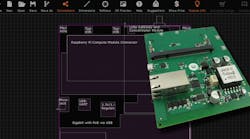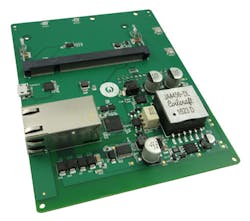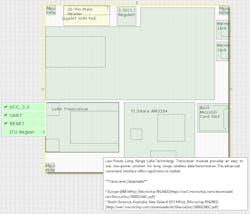Gumstix has used its own web-based, Geppetto design-to-order (D2O) tool to deliver it latest boards, including ones that incorporate power-over-Ethernet (PoE). The two PoE blocks allow developers to add PoE support to their designs using a drag-and-drop interface. One of its first boards using one of the PoE blocks is the Gumstix Pi Conduit PoE (Fig. 1). This allows a developer to use any Pi Compute module with a PoE switch using just an Ethernet cable. There is no need for a separate power brick that is typically required with an Ethernet device.
PoE designs are limited by the amount of power available over the network connection. The initial PoW spec (802.3af) delivered just under 13 W with a maximum of 15 W. The latest specification is 802.3bt Type 4 with a maximum power delivery of 100 W. PoE implementations support 10Base-T, 100Base-TX, and 1000Base-T. The Gumstix implementations support 1000Base-T.
PoE support and a board layout aren’t actually things to get excited about. PoE has been around for a long time, but designing a board from scratch with PoE support (without being a professional embedded designer) is a big deal. This is especially true given the cost and time it takes to create a design.
I used Geppetto to design a simple board like the Pi Conduit PoE using Texas Instrument’s Sitara AM3354 (Fig. 2). This particular board contained a header for a LoRa transceiver, the Gigabit Ethernet PoE interface, and the Sitara processor with an ARM Cortex-8. There was also a MicroSD socket and a pair of micro USB connectors, plus a header connected to some of the Sitara’s I/O pins. Connecting these actually took more time than laying out the board because I had to connect one pin at a time. The design took under an hour, most of which was spent playing with options ranging from layout to other peripherals, like a GPS interface.
The user interface is nice, showing items that need configuration in yellow. The interfaces needed show up on the left side of an item and interfaces it provides are on the right. Clicking on a needed interface shows items that can be linked if they are on the board; it shows devices in the menu that can be added to the board. Red indicates an error, like a board that is too small to hold everything.
Geppetto supports a range of computer-on-module (COM) sockets, like the one for the Pi Compute module, as well as a small selection of processors like the Sitara and a Cortex-M4 from STMicroelectronics. There is also a Microchip ATmega32U4 in the mix.
The latest addition is NXP’s SCM-i.MX 6D/Q [Dual, Quad] Core Single Chip System Module (SCM). The SCM combines an i.MX 6 quad- or dual-core applications processor, NXP MMPF0100 power management system, integrated flash memory, more than 100 passives, and up to 2 GB DDR2 Package-on-Package RAM into a single-chip solution. Geppetto can be used to connect this module to peripherals or connectors like any other processor or COM module.
Geppetto keeps a running tally of the costs. There is a fixed $1,999 set-up fee and a per-unit cost. For this design, it was about $165. This includes delivery of a fully functional board in three weeks. Of course, one would probably order more than one board, and there are quantity discounts for large orders. The base price is for less than 60 boards, and there is another price break at 240 boards.
The costs for doing a design in-house or contracting it out would be significantly higher. There are tradeoffs such as a more limited selection of devices and processors. Likewise, the board layout would not be the smallest and it could not take into account a wide range of circuit board features that are possible with a custom design.
Geppetto also kicks out a PDF file with board documentation that is a nice starting point for a final product. It will also provide a 3D view of the board.
Geppetto can also be used to create a Raspberry Pi HAT (Hardware Attached on Top). Designing a board with a LoRa transceiver, a 9-axis IMU, and an ambient temperature sensor took only a few minutes.
Gumstix continues to add new processors, COM modules, peripherals, etc., often in response to customer demands or when it is working with partners.




